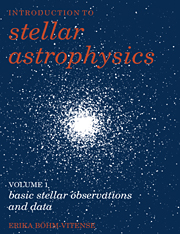Book contents
- Frontmatter
- Contents
- Preface
- 1 Positions of stars
- 2 Proper motions of stars
- 3 Distances of nearby stars
- 4 The brightnesses of the stars
- 5 Color magnitude diagrams
- 6 The luminosities of the stars
- 7 Angular radii of stars
- 8 Effective temperatures of stars
- 9 Masses and radii of stars
- 10 Spectral classification
- 11 Understanding stellar spectra
- 12 Population II stars
- 13 Stellar rotation
- 14 Stellar magnetic fields
- 15 Stars with peculiar spectra
- 16 Pulsating stars
- 17 Explosive stars
- 18 Our sun
- 19 Interstellar absorption
- Appendixes
- References
- Index
15 - Stars with peculiar spectra
Published online by Cambridge University Press: 04 August 2010
- Frontmatter
- Contents
- Preface
- 1 Positions of stars
- 2 Proper motions of stars
- 3 Distances of nearby stars
- 4 The brightnesses of the stars
- 5 Color magnitude diagrams
- 6 The luminosities of the stars
- 7 Angular radii of stars
- 8 Effective temperatures of stars
- 9 Masses and radii of stars
- 10 Spectral classification
- 11 Understanding stellar spectra
- 12 Population II stars
- 13 Stellar rotation
- 14 Stellar magnetic fields
- 15 Stars with peculiar spectra
- 16 Pulsating stars
- 17 Explosive stars
- 18 Our sun
- 19 Interstellar absorption
- Appendixes
- References
- Index
Summary
General discussion
In the previous sections we have discussed stars which are generally considered to be normal stars, which means their spectra fit into the two-dimensional classification scheme according to spectral type and luminosity. True, the weak-lined stars, or population II stars, do not fit into that scheme, but generally their peculiarity can be understood by the change of just one parameter, the ratio of the metal abundance to the hydrogen abundance, though recently it has been found that this may not always be the case. More than one parameter may actually be necessary to describe the abundances of the heavy elements. The population II stars are still generally considered to be ‘normal’ stars because we believe that all their peculiarities can apparently be traced back to different chemical abundances. For the stars we are going to discuss in this chapter, this does not seem to be the case. There are, of course, a large number of different kinds of peculiar stars, but we are not able to discuss all of them in the framework of this introduction to stellar astrophysics. We shall only discuss the most frequent kinds of peculiar stars and those which are of special interest in the framework of understanding stellar structure and evolution.
Peculiar A stars, or magnetic stars
The observations
In the previous section we saw that some stars with very strong magnetic fields are found among the early A stars.
- Type
- Chapter
- Information
- Introduction to Stellar Astrophysics , pp. 127 - 152Publisher: Cambridge University PressPrint publication year: 1989



